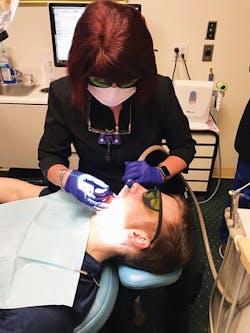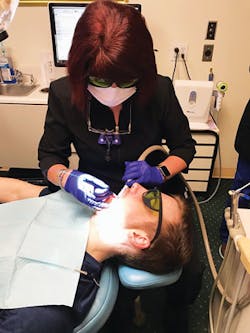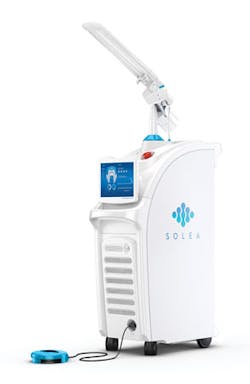What it takes to be a laser hygienist: Training options, legal issues should be addressed
By Angie Wallace, RDH
With all of the technological advancements in our world of dental hygiene, lasers are here to stay. They are truly changing the way dental professionals practice. We now see patients seeking out what lasers can do for them, as well as researchers and clinicians who continue to place the highest value on lasers’ capabilities. In addition, more “everyday” clinicians are looking to see how lasers can increase practice efficiency and profitability.
To get the most out of what lasers can do for your practice as a hygienist, the best place to start is with education. To begin, hygienists interested in laser technology should start by doing their homework. Familiarize yourself by reading industry publications about lasers, take a few online classes and attend some seminars. Check and compare laser manufacturers and their offerings to discover which laser will work best for you.
When you are ready, take the next step and consider attending an official meeting that will educate you even further about lasers. The Academy of Laser Dentistry (laserdentistry.org) hosts an annual meeting as well as other training opportunities throughout the year. ALD is the only unbiased organization in regards to lasers, which means that they work with all levels of laser users on all different lasers. ALD laser educators provide laser courses throughout the United States and internationally, and a few of the educators can even provide laser education right in your office.
There are things you should carefully consider before you just start using a laser on your patients. What do I want to use it for? Which laser should I use? What training or certification should I have before I use my laser? What code can I use to be reimbursed?
Let’s examine these questions.
Since currettage is no longer an accepted stand-alone procedure with the American Academy of Periodontology, lasers cannot be used by hygienists to cut tissue outside of states that allow hygienists to perform curettage, just like we can’t use any other dental tool to cut tissue either.
Depending on your state, some common procedures that can be performed with lasers by hygienists are bacterial reduction, sulcular debridement, and bacterial decontamination. Done with lasers, these procedures allow the tissue a chance to heal and new attachments to form, making the pocket easier to maintain. Moreover, laser therapy in general is antimicrobial and decreases virulent red-complex bacteria that can invade soft tissue and enter blood vessels, affecting overall health.
Other hygiene uses for the laser include treatment of herpetic lesions or aphthous ulcers. These procedures are great practice builders since patients are typically very pleased with results. Since there are few over-the-counter treatments for herpetic lesions, lasers allow us to eliminate the pain from lesions, healing is significantly faster, and using a laser decreases the odds of the lesions reoccurring in the same area. Some other procedures that lasers provide superior results with are:
- Laser bacterial reduction (LBR) - We can eliminate bacteria at any hygiene appointment prior to completing hygiene procedures. LBR is the practice of administering low power laser energy within the sulcus throughout the entire dentition. This helps to reduce bacteremia, cross contamination, and bacterial load and, in turn, helps prevent attachment loss.
- Laser assisted periodontal therapy (LAPT) - Used for active periodontal therapy (SRP with laser decontamination) and in conjunction with traditional deep scaling appointments, LAPT is the practice of administering laser energy within the periodontal pocket for profound decontamination. LAPT also results in increased tissue interaction by removing the inflammatory factors, significantly reducing bacteria within the pocket, and consequently promoting growth factors for healing with the ultimate goal of tissue rehabilitation.
- Desensitizing of tooth structure - Laser energy is used to eliminate sensitivity on the tooth structure.
- Laser bleaching - Laser technology is applied to activate bleaching solution to whiten teeth.
- Photobiomodulation (PBM) - The laser is used for wound healing and pain management.
Once you determine what your clinical goals are in using a laser in practice, there are many lasers to choose from. Much like when you purchase a vehicle, it can be one that just gets you from point A to point B, or it can have all the bells and whistles that everyone loves. Look for one that fits what you actually want to do in order to benefit your practice and patients.
Types of Lasers
Laser procedures that a hygienist can use their laser for will depend on which laser they are using. These days, there are many lasers to choose from. This variety provides individual options so you can decide which one is the best suited for your practice.
Types of lasers include: Er:YAG and Er:CrYSGG, Diodes, Nd:YAG, and CO₂. Each has unique characteristics and there are several manufacturers that specialize in each type.
- Er:YAG and Er:CrYSGG lasers are hard tissue lasers that are attracted to water and hydroxyapatite. Both are primarily used by dentists due to the attraction to tooth surface and higher costs to purchase and maintain. Dentists often use these lasers to perform just about any procedure that can be done using traditional instruments such as bone re-contouring, prepping teeth for fillings or crowns, hard tissue crown lengthening, and exposure of teeth under bone.
- The most economical dental lasers are diode lasers. These are soft-tissue lasers that doctors often purchase as their first laser, occasionally passing them onto their hygiene team. Because they are very economical and easy to use, Diodes are the most commonly used lasers that hygienists incorporate into practice to perform all of the procedures listed above. In my personal experience, an example of a very capable diode laser is the Beamer STL laser (King Dental Company). It is economical, portable, easily moved from operatory to operatory, and delivers very competent results.
- Nd:YAG lasers have been used in dental practices since the early 1990s. These lasers were one of the first used by clinicians until diodes became available in 2005.They are primarily soft tissue lasers that can be used for many of the same procedures as diodes. They are a little pricier than diodes and a bit larger in size but are still used by both hygiene and dental professionals today. An example of a popular Nd:YAG laser is the Millennium Laser, patented for the LANAP Protocol.
- As a laser educator, several hygienists have asked me about CO₂lasers. I am a big proponent of CO2 lasers. They are highly absorbed in tissue due to the interaction of water, and are superior at cutting soft tissue without blood. Two very popular ones are Deka and Denta RF (GPT Dental), which continue to impress hygienists and their patients with results. In addition, newer lasers continue to provide even more options for dental hygienists and greatly improve the patient experience (see sidebar).
Whichever laser you use make sure you know what you, as a hygienist, are actually able to do legally with your laser. This begins by becoming familiar with your state practice act. It is your responsibility to read your particular state practice act and then determine if you can utilize your laser in the state that you reside in, performing the procedures that you set out to do. If these rules change, which they are known to do from time to time, you need to keep up with these changes. Also, remember that if you are not able to do these procedures without a laser, then you will not be able to complete them even if you have a laser.
Once you determine what laser you will be using and what the laser is capable of doing clinically, your state practice act will determine if you’ll require training or a certification course. The class should encompass at least eight hours of tutorial and four hours of hands-on training to build competency and proficiency. Most states require only basic knowledge but as lasers continue to evolve it is highly recommended to take all the laser classes you can to educate yourself on the evolving techniques and applications for your laser.
Many laser manufacturers also provide training or videos to get you started. Please remember that most of this type of training is just enough to merely get you started. I highly recommend additional, more detailed training or certification to perfect your techniques and to safely incorporate your laser into practice.
Once you start integrating lasers into your clinical armamentarium, hygienists can use the dental codes that we already have available. There are no “extra” codes for lasers and dental hygiene procedures. In other words, we adjust fees appropriately for the codes we already have.
I hope that I have sparked an interest for you with lasers. Please do not hesitate to contact me with any additional questions about the role that lasers can play in your practice at [email protected]. RDH
Benefits of new CO2 laser
We recently incorporated the Solea CO2 laser (Convergent Dental) into our practice. Although CO2 lasers are primarily used for soft tissue procedures, Solea is very unique in that it is the first CO2 laser system cleared by the FDA for hard, soft, and osseous tissue in dentistry and has provided numerous practice advantages to both me and the dentist. Solea has an intuitive touch screen that makes it extremely easy to learn and use. They are constantly upgrading through software updates that make the practice of laser dentistry easy enough for anyone to practice, and my patients absolutely love it.
Solea offers quicker healing times, painless procedures, decreased bleeding, and minimal post-op discomfort. It can be used by hygienists on periodontal/sulcular debridement of root surfaces, palliative care for aphthous ulcers, herpetic lesions and other oral wounds. In addition, the training and ongoing support provided by Convergent Dental is second to none.
Angie Wallace, RDH, is an Academy of Laser Dentistry (ALD) recognized educator with advanced level proficiency and mastership credentials. Wallace teaches in-office laser certification courses throughout the United States and Canada. She also practices clinically four days per week and has over 25 years of clinical dental hygiene experience.


